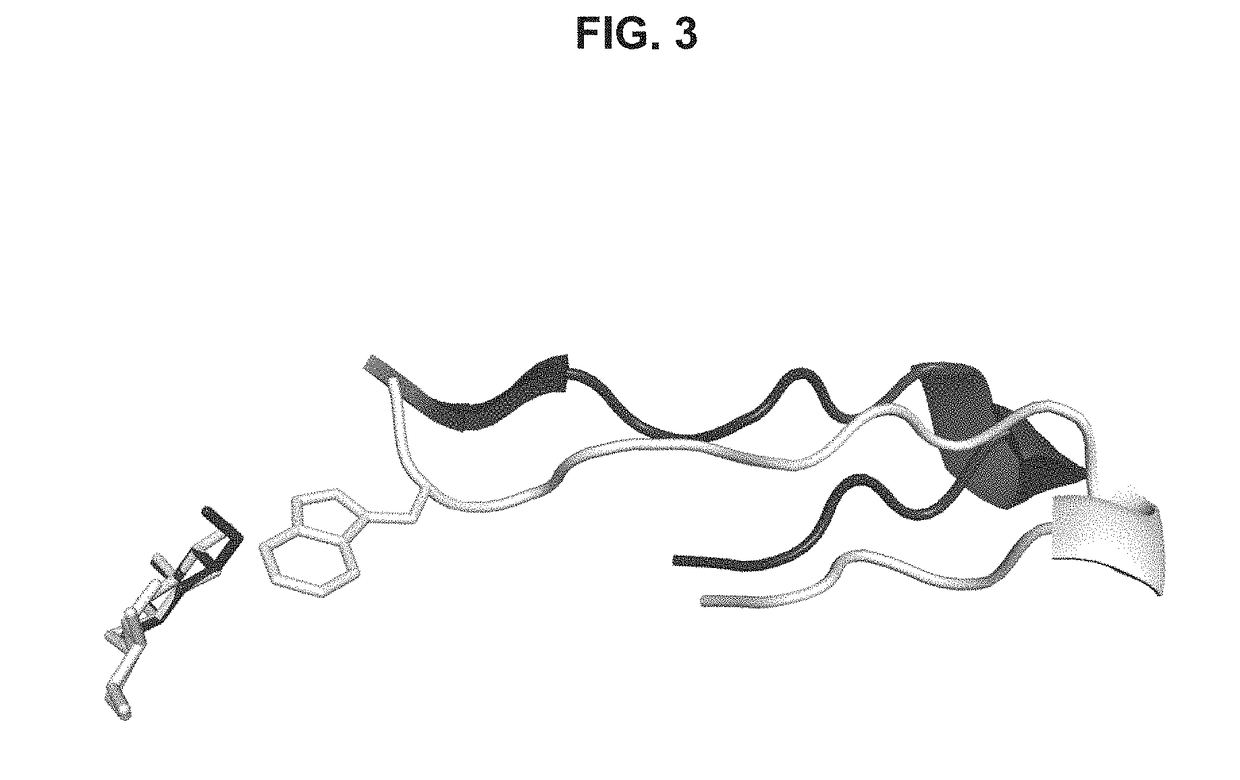Engineered multifunctional enzymes and methods of use
a technology of glycosyl hydrolase and enzymes, applied in hydrolases, enzymes, biochemical equipment and processes, etc., can solve the problems of key bottlenecks in commercial viability, production and reliably supply of such enzymes, and achieve the same level of hydrolysis of a given substrate, improve biomass hydrolysis performance, and equal
- Summary
- Abstract
- Description
- Claims
- Application Information
AI Technical Summary
Benefits of technology
Problems solved by technology
Method used
Image
Examples
example 1
Purification of Trichoderma reesei Beta-Glucosidase I (Bgl1)
[0214]The native gene encoding Trichoderma reesei beta-glucosidase I (Bgl1) (UniProt Q12715) was overexpressed in a Trichoderma reesei strain lacking four genes coding for cellulases (cbh1, cbh2, egl1, egl2). The target genes were cloned into the pTrex3G vector (amdSR, ampR, Pebh1), see, e.g., published application US 20070128690, and used to transform the above Trichoderma reesei strain. Transformants were picked from Vogel's minimal medium plates (see, Vogel H. J., (1956) A convenient growth medium for Neurospora (medium N), Microbial Genetics Bulletin, 13:42-43) containing acetamide, after 7 days of growth at 37° C. Those transformants were grown up in Vogel's minimal medium with a mixture of glucose and sophorose as a carbon source. The overexpressed proteins appeared as dominant proteins in culture supernatants, in that the Trichoderma reesei Bgl1 was approximately 80% pure as judged by visualization of the SDS-PAGE.
[0...
example 2
Crystallization, Data Collection, Structural Determination and Refinement of Trichoderma reesei Bgl1
[0217]The purified Bgl1 as described in Example 1 above was concentrated to 3.9 mg / mL in a buffer containing 25 mM NaAc (pH 4), and 100 mM NaCl. Bgl1 crystals were obtained using the hanging-drop vapor diffusion method at 20° C.
[0218]More specifically, the drops were prepared by mixing equal volume of protein sample and crystallization solution containing 0.1 M sodium formate, at pH 7.0, and10-20% PEG 3350. To produce Bgl1-glucose or Bgl1 (1-thio-beta-D-glucosyldisulfanyl)1-thio-beta-D-glucose (Bgl1-GSSG) complex crystals, Bgl1 crystals were soaked into the crystallization solution containing an addition of 50 mM glucose or 20 mM 4-thio-cellobiose for a period of 10 min before they were frozen.
[0219]Prior to data collection, crystals were frozen in liquid nitrogen, after the crystallization solution with 20% glycerol had been added as a cryo-protectant. Glucose was also added to the c...
example 3
Preparation and Purification of Trichoderma reesei Beta-Xylosidase Xyl3A
[0223]The gene encoding for Trichoderma reesei (or H. jecorina) Xyl3A (GenBank accession code CAA93248.1, UniProt accession code Q92458) (see, Margolles-Clark, E., et al., (1996) Cloning of Genes Encoding alpha-L-arabinofuranosidase and beta-xylosidase from Trichoderma reesei by expression in Saccharomyces cerevisiae. App. Environ. Microbiol. 62(10): 3840-46) has been sequenced from a H. jecorina QM6a cDNA library as described in Foreman P K et al. (2003) Transcriptional regulation of biomass-degrading enzymes in the filamentous fungus Trichoderma reese, J Biol Chem. August 22; 278 (34):31988-97. The open reading frame (ORF) of the gene was amplified from H. jecorina QM6a genomic DNA by PCR using the primers:
(SEQ ID NO: 6)bxl1F: 5′-CACCATGGTGAATAACGCAGCTC-3′;and(SEQ ID NO: 7)bxl1R: 5′-TTATGCGTCAGGTGTAGCATC-3′,
[0224]and inserted into pENTR / D-TOPO (Invitrogen Corp., Carlsbad, Calif.) using the TOPO cloning reactio...
PUM
| Property | Measurement | Unit |
|---|---|---|
| Tm | aaaaa | aaaaa |
| Tm | aaaaa | aaaaa |
| Tm | aaaaa | aaaaa |
Abstract
Description
Claims
Application Information
 Login to View More
Login to View More - R&D
- Intellectual Property
- Life Sciences
- Materials
- Tech Scout
- Unparalleled Data Quality
- Higher Quality Content
- 60% Fewer Hallucinations
Browse by: Latest US Patents, China's latest patents, Technical Efficacy Thesaurus, Application Domain, Technology Topic, Popular Technical Reports.
© 2025 PatSnap. All rights reserved.Legal|Privacy policy|Modern Slavery Act Transparency Statement|Sitemap|About US| Contact US: help@patsnap.com



